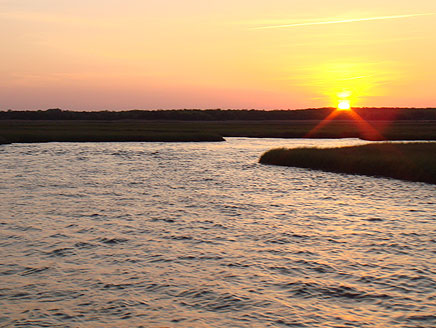

The tasty brackish water fish, the white perch, seems to have been under-fished in recent years, but the local folk know that in winter and early spring, these tasty silver-backs can make quite a nice little dinner!...
Photos and Story by Bob Misak
When do you find perch?
Early in the year, when the winter flounder fishermen at the New Jersey shore are picking at what's left of the flounder and waiting for the striped bass to arrive, there is a little lull in the fishing action. This slow period runs from January to the end of April, and by then the stripers are beginning their spring run. But in between that time, the white perch come through to spawn. They visit the creeks and streams that dump fresh water into salt marshes and lagoons, and they come in large numbers. When you catch a good day, you can fill up a bucket in a very short time. Prior to the spawn, white perch tend to be a lot larger in size, so you really want to start looking for them in mid to late January and into February, so you can try to catch the pre- spawning period. This isn't very long, only a week or two. Certain lagoons around South Jersey, as well as bigger flows like the Mullica River and such, are the places where big, early perch can be found. You won't catch them in large numbers like you will after the spawn is over, but again, they will be a lot bigger, one and a half all the way up to three pounds each. Often they will be in a spot that nobody knows, or even cares about at that time of year. And, once found, perch make a great table treat as well. It's a great way to teach the younger fisherman to catch and handle fish on their own, so it's a great way to start out the beginners in the family. We all know that when teaching a kid to fish, you will definitely keep them interested easier if they're busy reeling in fish one after the other.
 |
| High tide at dusk is the perfect time for white perch. |
How do you find 'em?
When looking for white perch during the spring, the best spots to look are places where decent sized bodies of fresh water empty into salt marshes or lagoons. This is where the perch tend to stack up. You may have to try two or three spots in any one area, just like flounder fishing. But once you have found a school of perch, you'll know it on the first toss of the line. If you have extra shrimp, chumming them in is a big help, like most school fish. And they are definitely school fish, so where there one...there's tons, especially when the water has warmed in Mid-April. A natural tidal current is also a big help, though not always necessary. Smaller boats like Jon boats and small motorized rowboats are ideal for chasing perch, but if you're up in the salt marshes, you need to watch your tides, because in these areas you can end up high and dry waiting for the tide to come back in. This is no way to spend a chilly night, stuck out on a salt marsh with no cover from the elements. It's just best to target perch when you have calm, warm evenings and a high tide around dusk. This is the ideal time to successfully fill a bucket with the feisty little silver- backs. Although they are a smaller breed of fish, they fight quite vigorously on light tackle, and when they get real thick, catching two fish at once on a double rig is quite common. A word to the wise, though; don't keep all the small ones first, because you can catch so many that you can just keep the larger ones for eating.
 |
| Author Bob Misak shows off a nice catch of early season white perch.. |
Tackle and Bait Tips
Of course, light rods (six foot or less) and light reels that can cast either 8 or 10 lb. test are ideal for perch fishing. I like to use a mid-sized Styrofoam weighted float, because it sits upright in the water for easy hit detection, and if you need to cast to reach them, you can. Not that you'll need touchy equipment, because when a perch hits it's usually quite aggressively. That float will be gone in a second's time. The hook will be a small no.2 or no. 4, and I like a bait-holder barb on the hook to hold the bait on. The bait of choice is live grass shrimp, and catching your own is probably your best bet. The use of a long handled, fine mesh net around bridge pilings and meadow creeks are excellent places to net grass shrimp. Some bait shops sell live grass shrimp if you don't feel like going through the trouble of netting your own. Tackle shops dedicated to perch fishing, like Murphy's Hook House in Toms River, usually have a steady supply of lively shrimp during the perch run, and you can call around in your area to find some. In January and February, the sharpies who find big perch can't get bait, and gold or white herring darts or tiny spinners are used often. Also, I am a big fan of bringing along a bucket of the smallest minnows I can find, because the larger, more desirable eating perch tend to prefer a little larger bait. Also, you need to know this little secret; the deeper you set your hook, the more success you'll have. Perch lay near the bottom and hold tight to bulkheads when feeding, and your hook, or hooks, should be set at least three feet down and hugging the bulkhead, if you can. I like to fish deeper water and go down four to five feet, or even deeper, if possible, without touching bottom. I also use a small split shot just above my hooks to send those shrimp down faster. At the end of the spawn, the perch will move out of the tributaries, (in late April and into May) and they will be found in the deep meadow creeks for about ten days to two weeks. Though they may be a little smaller by this time, they school up in huge numbers. Catching these large numbers of perch allows you to cull out the smaller, harder to clean fish. Catching them during this post-spawn period is ideal for the young anglers in the family, as they tend to feed very aggressively. You can literally fill a bucket up in an hour or two. But again, watch your tides, and don't get yourself and your family stuck up in the marshes on a cool night. So Dad, if you're bored and the youngsters want to go fishing, or if you want to go fishing in early spring, go find some white perch. Put together a nice time, and also a nice meal for you and the kids. White perch are found just about anywhere in the state's tidal waters, so don't miss out on your opportunity to bring in the warm weather fishing season with a little "perchin'". And remember these two tips...perch like to feed on high tide, and feed at dusk. If you can catch a high tide around dusk, you have ideal perch fishing conditions. And, as in most early season fishing trips, try not to under-dress, or you might have to go home a lot earlier than you wanted to! Good luck and great fishing.














